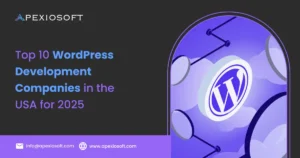Designing a custom web application is no small task. It requires a deep understanding of user needs, technical expertise, and a clear vision of the business goals. Custom web applications, unlike off-the-shelf solutions, are tailored to meet specific requirements, providing unique functionalities to businesses. Whether you’re a startup or a well-established enterprise, designing a custom web application can give you a competitive edge.
If you’re looking to build a high-quality custom web app, Apexiosoft, a leading web design and software development agency in the USA, is the right partner to guide you through the process. In this blog post, we will walk you through the best practices for designing custom web applications that are user-friendly, functional, and scalable.
Why Custom Web Application Design Matters
Custom web applications have several advantages over generic solutions. They are built specifically for your company’s needs, offering a tailored experience that improves efficiency and user engagement.
- Unique Business Needs: Custom applications are designed to serve specific business needs that off-the-shelf software cannot.
- Improved User Experience (UX): A well-designed application focuses on providing the best user experience, which can directly lead to higher conversions and customer satisfaction.
- Scalability: A custom solution is designed with future growth in mind. As your business grows, so will the application.
- Integration Flexibility: Custom web applications are easily integrated with other tools and systems.
For businesses in the USA looking to stand out in a competitive market, contact Apexiosoft for expert advice on custom web application design.
Key Considerations for Custom Web Application Design
Before diving into the design process, it’s essential to consider several key factors that can impact the success of your custom web application.
1. Understanding Business Requirements
The foundation of every great custom web application begins with understanding the business goals and user needs. Gathering detailed requirements ensures that the project aligns with both the company’s vision and the needs of its users.
Best Practice: Work closely with stakeholders to document functional and non-functional requirements. Include business objectives, user personas, and pain points.
2. User-Centered Design (UCD)
User-Centered Design (UCD) is a key component in creating web applications that users will love. This approach ensures that the design and functionality of the app are based on the needs, behaviors, and challenges of the end-users.
Best Practice: Regularly involve users in the design process, conduct usability testing, and gather feedback through surveys and focus groups. This will help ensure that the application is intuitive and efficient.
Design Principles for Custom Web Applications
3. Responsive Design
In today’s mobile-first world, ensuring that your custom web application looks and works well on all screen sizes is crucial. Responsive design adapts the layout and content to fit various devices, such as smartphones, tablets, and desktops.
Best Practice: Adopt a mobile-first approach to your custom web application design. This ensures that the user experience is optimized for smaller screens and gradually scales up for larger screens.
4. Clean and Simple User Interface (UI)
A simple, uncluttered UI ensures that users can navigate your application efficiently. Avoid excessive elements or complex designs that might overwhelm users. A clean design helps users focus on essential tasks.
Best Practice: Use a minimalistic design with intuitive navigation, making it easy for users to find what they need quickly. Consistency in colors, fonts, and button styles is also key.
5. Fast Load Times
Website speed is a critical factor in user retention. Slow-loading web applications can cause frustration and lead to higher bounce rates.
Best Practice: Optimize images, use lazy loading, and minimize unnecessary scripts. A fast-loading application contributes to a positive user experience.
Back-End Best Practices for Custom Web Application Design
6. Scalability and Flexibility
Custom web applications should be designed with scalability in mind. As your business grows, your application should be able to handle more users, transactions, and data without compromising performance.
Best Practice: Use cloud platforms like AWS or Azure to host your custom web application. These platforms offer scalable infrastructure that can grow as your business expands.
7. Security Features
Data security is non-negotiable in the design of any web application, especially when dealing with sensitive information. Implementing robust security measures protects both your business and your users.
Best Practice: Incorporate security features such as data encryption, two-factor authentication, and secure payment gateways. Regularly update your application to fix vulnerabilities.
8. Data Integration and API Design
Web applications often need to interact with other systems or databases. A well-designed API ensures smooth data integration, enabling your application to fetch, process, and present data in real-time.
Best Practice: Use RESTful APIs or GraphQL for easy communication between the frontend and backend. Ensure that your APIs are well-documented and scalable.
Performance Optimization in Web Application Design
9. Database Optimization
Efficient database design is crucial to ensuring that your custom web application performs well. Poorly structured databases can lead to slower response times and a negative user experience.
Best Practice: Normalize your database and implement indexing to improve performance. Regular database maintenance and optimization are also essential for keeping things running smoothly.
10. Caching and Content Delivery Networks (CDNs)
Caching can dramatically improve the performance of your custom web application by storing frequently accessed data in temporary storage. Using a CDN ensures that users can quickly access content from the server closest to them.
Best Practice: Implement server-side caching for frequently accessed data and integrate a CDN to serve static files like images, CSS, and JavaScript.
How Apexiosoft Ensures Best Practices for Web Application Design
At Apexiosoft, we specialize in custom web application design for businesses across the USA. Our team follows industry best practices to ensure that your custom web application is user-friendly, secure, and scalable.
Here’s how we do it:
- Tailored Solutions: We understand that every business has unique needs. That’s why we take the time to understand your objectives and design an application that perfectly fits your requirements.
- Agile Development: We use agile development methodologies, allowing for flexibility, faster delivery, and continuous improvements.
- UI/UX Expertise: Our design team is dedicated to creating intuitive user interfaces that provide the best user experience, ensuring high engagement and conversion rates.
- Security First: We prioritize security in every aspect of your web application, ensuring that your users’ data is always protected.
- Ongoing Support: We don’t just design and develop your application; we provide ongoing maintenance and support to ensure that it continues to perform optimally.
Contact Apexiosoft today for professional custom web application design services that cater to your business needs.
Final Thoughts on Custom Web Application Design
Designing a custom web application is an investment in your business’s future. By focusing on user-centered design, scalability, security, and performance, you can create a solution that not only meets your current needs but also adapts to future demands.
For businesses in the USA looking for a trusted partner in web application design, Apexiosoft offers expert guidance and development services. Contact us today to get started on your custom web application journey.
Looking for a custom web application design in USA? Contact Apexiosoft for expert advice and solutions tailored to your business needs. Let us help you bring your ideas to life with cutting-edge technology and exceptional design.


